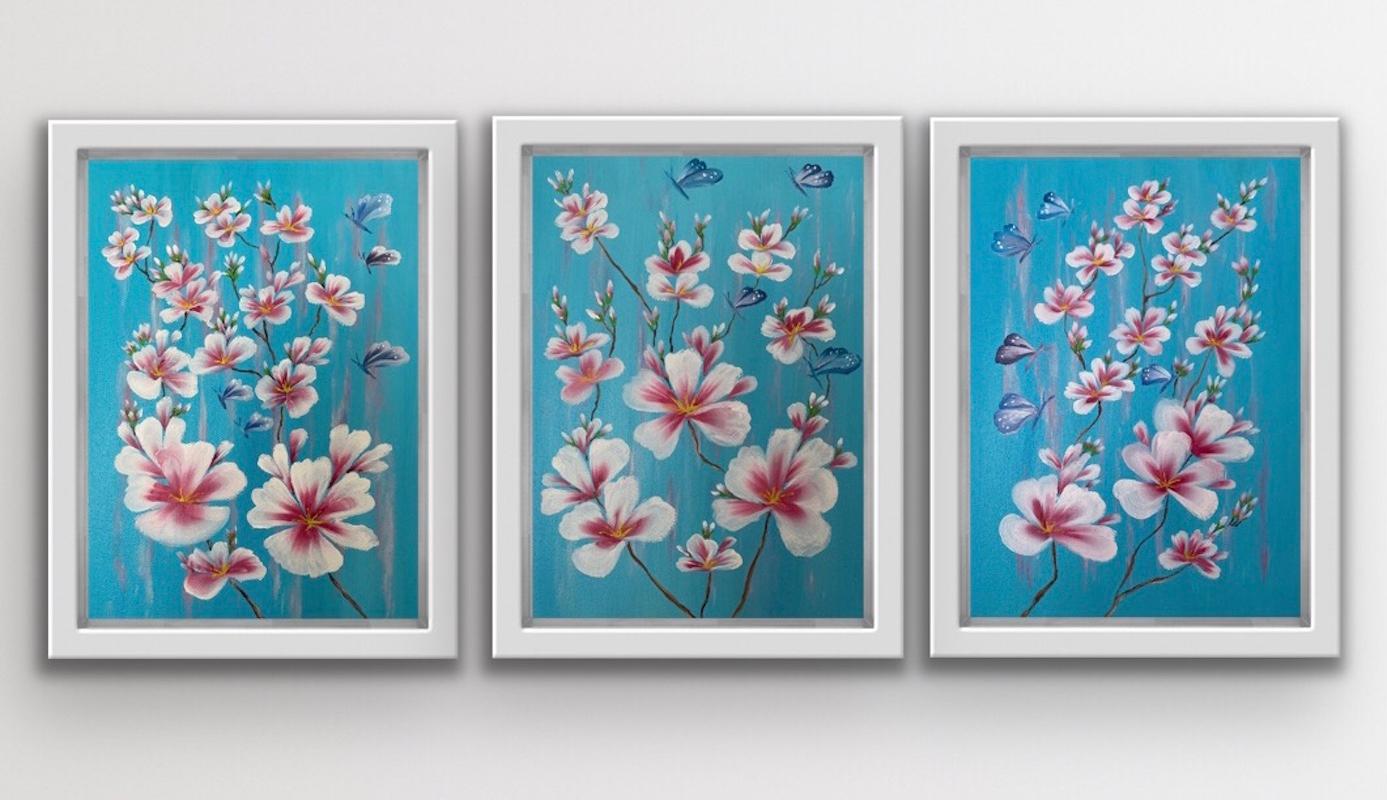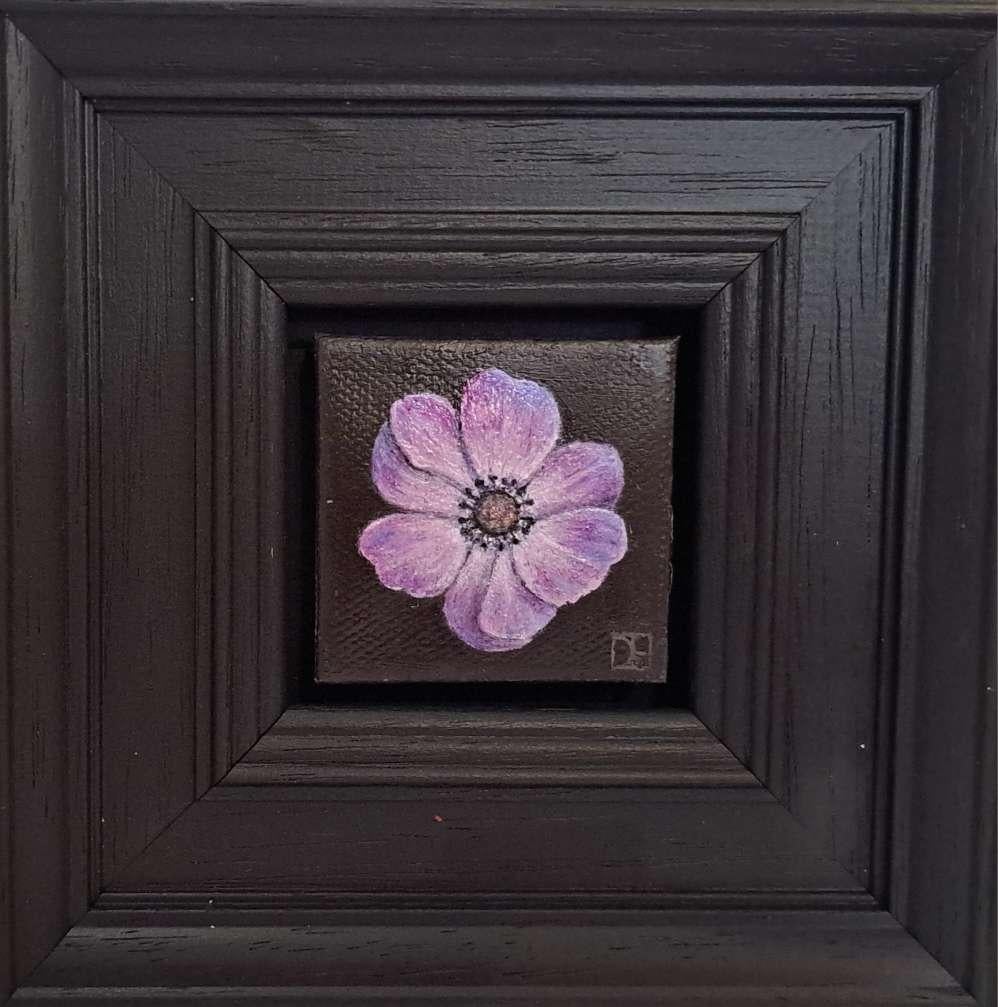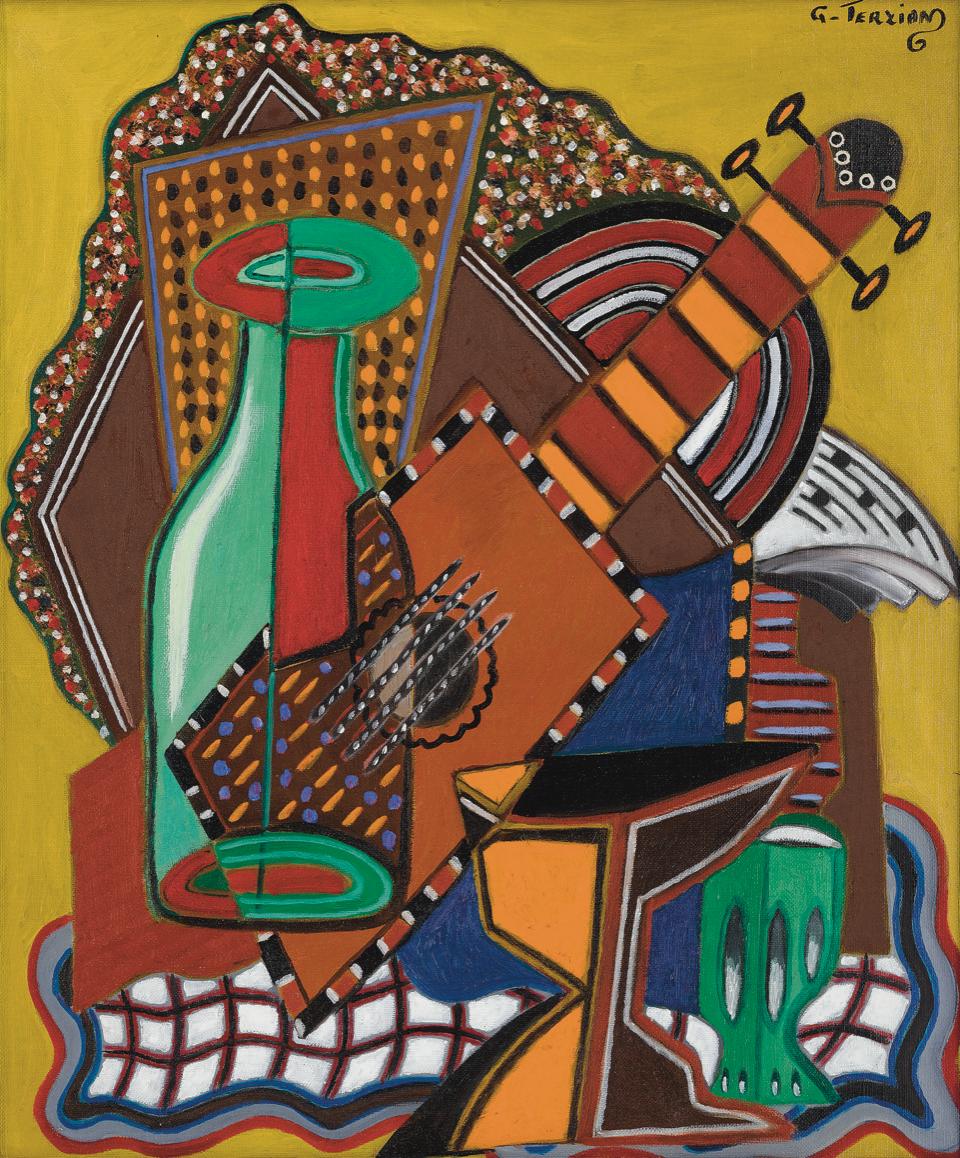Items Similar to "Tulips" Daphne Mumford, Bright and Colorful Floral Diptych
Want more images or videos?
Request additional images or videos from the seller
1 of 8
Daphne Mumford"Tulips" Daphne Mumford, Bright and Colorful Floral Diptych
About the Item
Daphne Mumford
Tulips
Signed lower right, titled on each stretcher
Oil on canvas, diptych
24 x 74 inches
Daphne Mumford studied at the Skowhegan School of Painting in 1952; the Chelsea School of Art, London in 1952-53; and the Brooklyn Museum School of Art in 1953-54.
She was a member of the Tenth Street cooperative, the Area Gallery, where she had two solo exhibitions in 1958 and 1959. In the 1970s she was a founding member of the Landmark Gallery in SoHo, where she was the subject of five solo exhibitions, and participated in several group shows.
Mumford lived in Manhattan before moving with her family to Brooklyn Heights and spending summers in mid-coast Maine. Her earliest work, often portraits of those closest to her, was distinguished by symbolist overtones and subtle, "primitive" drama. By the early 1970s, she turned to a greater degree of naturalism in her depiction of figures, although the environments and interiors were often imagined: a response to either the subjects or intuitive mark-making.
Mumford's work -- with its clear silhouettes, simplified planar areas, patterns of textiles, and the mimimalist geometries of interiors and exteriors -- bears a relationship to contemporaries such as Alex Katz and Will Barnet. Mumford tended to focus her gaze on her family: her two daughters (one of whom was a dancer) and their friends.
- Creator:Daphne Mumford (1934)
- Dimensions:Height: 24 in (60.96 cm)Width: 74 in (187.96 cm)
- Medium:
- Period:
- Condition:
- Gallery Location:New York, NY
- Reference Number:1stDibs: LU1841214351132
About the Seller
5.0
Platinum Seller
These expertly vetted sellers are 1stDibs' most experienced sellers and are rated highest by our customers.
Established in 2021
1stDibs seller since 2022
63 sales on 1stDibs
Typical response time: <1 hour
- ShippingRetrieving quote...Ships From: New York, NY
- Return PolicyA return for this item may be initiated within 3 days of delivery.
More From This SellerView All
- "Candelabra, " Edward Millman, Colorful Abstract Expressionist Still LifeLocated in New York, NYEdward Millman (1907 - 1964) Candelabra, 1962 Signed lower right; titled and dated on the reverse Oil on canvas 41 3/4 x 31 1/2 inches Provenance: The ...Category
1960s Abstract Abstract Paintings
MaterialsCanvas, Oil
- "Still Life of Fruit, " Albert Swinden, American Abstract Association, AAABy Albert SwindenLocated in New York, NYAlbert Swinden (1901 - 1961) Still Life of Fruit, 1937 Oil on canvas 18 x 30 inches Provenance: Graham Gallery, New York Albert Swinden (1901–1961) was an English-born American abstract painter. He was one of the founders of the American Abstract Artists, and he created significant murals as part of the Federal Art Project. Albert Swinden was born in Birmingham, England in 1901. When he was seven, he moved with his family to Canada, and in 1919 he immigrated to the United States. He lived in Chicago, where he studied for about a year and a half at the Art Institute. He then relocated to New York City, where his art education continued briefly at the National Academy of Design. He soon changed schools again, to the Art Students League, which he attended from 1930 to 1934. He studied with Hans Hofmann and gained an appreciation for Synthetic Cubism and Neoplasticism. According to painter and printmaker George McNeil, Swinden "could have influenced Hofmann ... He was working with very, very simple planes, not in this sort of Cubistic manner. Swinden was working synthetically at this time." While still a student, Swinden began teaching at the Art Students League, in 1932. Swinden married Rebecca Palter (1912–1998), from New York. Their daughter, Alice Swinden Carter, also became an artist. Carter, who attended the School of the Museum of Fine Arts, Boston, received an award from the Institute of Contemporary Art, Boston for her large sculptures. Swinden was hired for the Federal Art Project (FAP) of the Works Progress Administration (WPA), and he is best known for the murals which he painted as part of that project. In 1935, New York City Mayor Fiorello La Guardia attended the opening of the inaugural exhibit at the Federal Art Project Gallery, accompanied by Audrey McMahon, New York regional director for the Works Progress Administration/Federal Art Project. Among the works on display was Abstraction, a sketch by Swinden; it was the design for a mural planned for the College of the City of New York. A newspaper account described it as consisting of "brightly colored T-squares, triangles and rulers in horizontal, vertical and diagonal positions". La Guardia asked what it was, and upon being told it was a mural design, he said he didn't know what it depicted. Someone joked that it could be a map of Manhattan. The displeased mayor stated that "if that's art, I belong to Tammany Hall." (Tammany Hall, which the Republican mayor referenced, was the New York Democratic Party political society.) Fearing that the mayor's negative attitude could jeopardize the future of abstract art within the Federal Art Project, McMahon dispatched an assistant to summon an artist who could speak to the mayor in defense of abstraction. The assistant returned with Arshile Gorky. Swinden played an important role in the founding of the American Abstract Artists. In 1935, he met with three friends, Rosalind Bengelsdorf, her future husband Byron Browne, and Ibram Lassaw, with the goal of exhibiting together. The group grew and started meeting in Swinden's studio, which adjoined those of Balcomb and Gertrude Greene...Category
1930s Modern Still-life Paintings
MaterialsCanvas, Oil
- "Still Life with Pink Ewer and Sheet Music" Nicholas Alden Brooks, Trompe L'oeilBy Nicholas Alden BrooksLocated in New York, NYNicholas Alden Brooks Still Life with Pink Ewer and Sheet Music, 1891 Signed and dated lower right Oil on canvas 20 1/8 x 16 inches Considerable mystery surrounds the name Nicholas Alden Brooks. Other than having been active in New York City between 1880 and 1904, very little is known about the artist. There are no records of any art societies showing him as a member or his having participated in any exhibits. The name Brooks, in fact, could possibly be a pseudonym for Robert Fullington, whose name appears on theatrical memorabilia in Brookss trompe loeil still-life paintings. William Harnett...Category
1890s Realist Still-life Paintings
MaterialsCanvas, Oil
- "Lemons and Pear" Marsden Hartley, Colorful Fruit Still Life, Modern ArtBy Marsden HartleyLocated in New York, NYMarsden Hartley Lemons and Pear, circa 1922-23 Oil on canvas 9 x 10 3/4 inches Provenance: Adelaide Shaffer Kuntz, Bronxville (Hartley’s friend and patron) Bertha Schaefer Gallery, New York (acquired from the above) Private Collection, Stamford, Connecticut (acquired from the above) Barridoff Galleries, Portland, Maine, April 7, 1984, Lot 29 (as Still Life with Pear and Lemons) Richard Ward Foster (acquired at above sale) Sotheby's New York, American Art, October 6, 2017, Lot 32 Private Collection (acquired from the above) Exhibited: (possibly) Kantstrasse, Berlin, Private showing in artist’s studio, 1923. (possibly) New York, Bertha Schaefer Gallery, Still Life Painting by European and American Painters, 1944. Born in Lewiston, Maine, Marsden Hartley became one of the most famous early modernist artists of twentieth-century American art, known for landscapes, still lifes, and some portraits. His painting showed a focus on monumental shapes, especially clouds and landscape forms, and his unique style has been described by critic Sadakichi Hartmann as "an extreme and up-to-date impressionism" and "emerging modernism that evolved through Impressionism". (Gerdts 291) He had a lonely, insecure childhood because his mother died when he was eight years old, and he was raised by an older sister when his father left to remarry. He studied art in Cleveland, Ohio and then in 1898 went to the Chase School in New York and at the National Academy of Design. He continued to spend much time in Maine painting landscapes, and by 1909 had his first exhibition, which was held at New York Gallery 291, run by Alfred Stieglitz. There he became involved with a social circle of modernists that included Georgia O'Keeffe, Arthur Dove, and John Marin. In 1912, he first went to Europe where he had further exposure to modernism, and from 1913 to 1915 he was in Germany. In Paris, he experimented with Cezanne-like still lifes and was befriended by Gertrude Stein. In Germany, he was influenced by Expressionism, and especially by military pageantry. It is said that his greatest contribution to early 20th-century American modernism has been his brilliant synthetic military icons known as German Officer Portraits. He developed a close homosexual relationship with a handsome young Prussian officer who was killed in World War I. Being encouraged by Stieglitz to explore American subjects, Hartley turned to American Indian objects...Category
1920s Still-life Paintings
MaterialsCanvas, Oil
- "The Tailor Shop" Suzanne Lalique, French Still Life, Measuring Tape, FabricBy Suzanne LaliqueLocated in New York, NYSuzanne Lalique The Tailor Shop, 1929 Signed and dated upper left Oil on canvas 13 x 16 inches Suzanne Lalique was born in 1892, the daughter of René Lalique and Alice Ledru. She wa...Category
1920s Still-life Paintings
MaterialsCanvas, Oil
- "Ethnographic Still Life, " Edith Kramer, African Mask and Shofar, Art TherapyBy Edith KramerLocated in New York, NYEdith Kramer (1916 - 2014) Still Life with Mask, n.d. Oil on canvas 26 x 20 inches Signed and titled on the stretcher Provenance: Estate of the artist Kramer was born in Vienna, Austria-Hungary in 1916. At age 13 Kramer began art lessons with Friedl Dicker. Dicker was graduate of the Bauhaus in Weimar, Germany and was an artist and art teacher of note. Kramer studied drawing, sculpture and painting, and was influenced by the method for teaching art developed by Bauhaus artist Johannes Itten. It was in 1934 after Kramer graduated from Realgymnasium that she, then 18, followed Dicker to Prague to continue to study under her. During this time in Prague, Kramer witnessed the therapeutic impact of art when she assisted Dicker in teaching art to the children of political refugees. With the threat of Nazi invasion looming, Kramer took refuge in America in 1938. In New York City, she worked for three years teaching sculpture at a progressive school called the Little Red School House. During World War II Kramer worked as a machinist at a tool and die shop in the Soho district of New York City. She stayed after her shift to draw the other workers in their industrial setting. These works were rendered in the social realist style. In 1947 Kramer visited some of the earliest known artwork, in the caves at Lascaux. Kramer spoke of these cave paintings as an example of the universal language of art. At the age of 33 she returned to New York City, with hopes of making a living as an artist. Still in her 33rd year, Kramer was offered a job at Wiltwyck School for Boys, a school and residential treatment facility for children with behavioral and emotional needs. This job was arranged for her by psychoanalyst and board member at Wiltwyck, Dr. Viola Bernard. Dr. Bernard gave Kramer the title, "Art Therapist," noting that few teachers were willing to work with such challenging students. It was here that Kramer worked with disturbed boys, ages 8 through 13, for the following seven years. Raised in a family which was interested in psychoanalytic theory, Kramer herself became a follower of Sigmund Freud. Kramer especially believed in the concept of sublimation. Freudian theory describes sublimation as a process in which primitive urges coming from the id are transformed into socially productive activities that lead to gratification of the original urge. Kramer's training was in art, art education and psychoanalytically informed psychotherapy. Kramer believed sublimation to be one of the most vital goals of art therapy...Category
20th Century American Modern Still-life Paintings
MaterialsCanvas, Oil
You May Also Like
- Blossom TriptychBy Tania OkoLocated in Deddington, GBBlossom Triptych Overall framed size cm : H89.1 x W63 Blossom by Tania Oko [2022] original Oil paint on deep canvas Image size: H:29.7 cm x W:21 cm Complete...Category
2010s Contemporary Figurative Paintings
MaterialsCanvas, Oil
- Pocket Mauve Anemone 2 (c), Original Painting, Flower, Nature, Spring artBy Dani HumberstoneLocated in Deddington, GBPocket Mauve Anemone 2 (c) is an original oil painting by Dani Humberstone as part of her Pocket Painting series featuring small scale realistic oil paintings, with a nod to baroque ...Category
2010s Realist Still-life Paintings
MaterialsCanvas, Oil
- "Dripping Dots - Coco in the Jungle" Contemporary Oil Painting on CanvasBy Cindy ShaoulLocated in New York, NYThis piece is part of an exciting new collection depicting iconic "Coco Chanel" with the artist's "Dripping Dots" style. Focused on a pointillistic technique, the paint is able to ca...Category
2010s Contemporary Abstract Paintings
MaterialsCanvas, Oil
- La Bouteille 2001 Oil on Canvas - Post Cubist Still Life Guitar & Bottle MusicBy Georges TerzianLocated in Rancho Santa Fe, CAGeorges Terzian (French 1939 - 2021) La Bouteille, 2001 Oil on canvas 21.5 x 18 inches (55 x 46 cm) Framed: 27 ½ x 24 inches (69.8 x 61 cm) Signed: G. Terzian Signed, dated and tit...Category
Early 2000s Cubist Still-life Paintings
MaterialsCanvas, Oil
- Still Life with Cherries and Roses, Oil PaintingLocated in Long Island City, NYArtist: Unknown Title: Still Life with Cherries and Roses Year: Circa 1950 Medium: Oil on Canvas, signed illegibly l.l. Size: 15 x 18 in....Category
1950s Impressionist Still-life Paintings
MaterialsCanvas, Oil
- Still Life with Wine Glass, Photorealist Oil Painting by Alejandra GauzenLocated in Long Island City, NYArtist: Alejandra Gauzen, Chilean (1967 - ) Title: Still Life with Wine Glass Year: circa 2000 Medium: Oil on Canvas, signed l.r. Size: 30.5...Category
21st Century and Contemporary American Realist Still-life Paintings
MaterialsCanvas, Oil
Recently Viewed
View AllMore Ways To Browse
Family Floral
Bright Floral
Spendor Vintage
Vintage Framed Silhouettes
Silhouette Floral
Area 54
Soho 1970s
Still Life Diptych
Dancing Bear Painting
Brooklyn Heights
Early Silhouette Portrait
Silhouette Two Friends
Alex Katz Dancer
Alex Katz Maine
Monkey Still Life
Still Life Chinese Porcelain
Sunflowers Van Gogh
Two Eagles On A Tree



